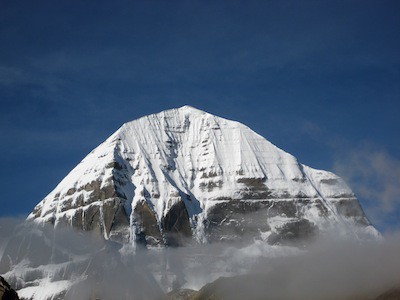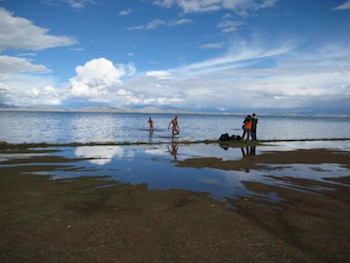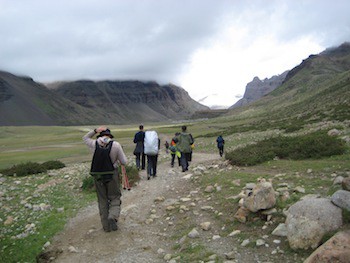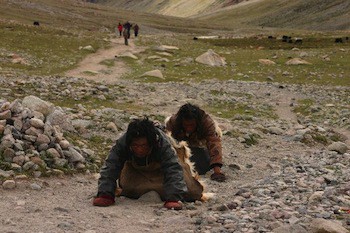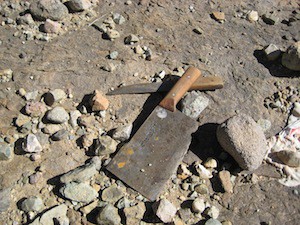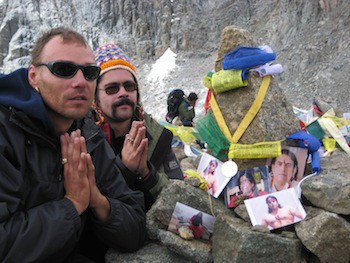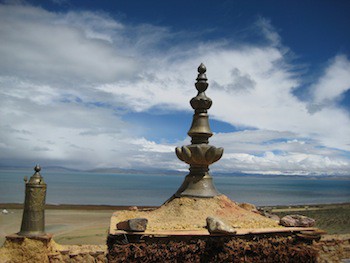In Sanskrit the word Kailāśā means “crystal”. In Tibetan this mountain is named Gang Rinpoche that means “jewelry of snow”. In a tradition of Indian Jainism it is called Ashtapada. This unique mountain (its height is 6740 m) is considered to be sacred in many religions of the East: Hindus, Buddhists, followers of pre-Buddhist Tibetan Bon religion and Jainas. The mountain is located in Tibet close to the sacred lake of Manasarowar. Since 1950s this territory is occupied by China.
According to the Indian legends, Lord Shiva, the first teacher of yoga, the destroyer of evil and grieve, lives on the top of Kailas mountain where he is sitting in meditation together with his wife named Parvati, a daughter of the Himalayas. Kubera, Indian and Tibetan God of wealth, also lives on this mountain or somewhere close to it. In many Hindu schools Kailas is considered to be a spiritual centre of the world where the souls of believers go after their death. According to the description in Vishnu Purana, in a divine world four sides of Kailas are made of crystal, ruby, gold and lapis lazuli, and it is the centre of a world’s mandala surrounded by a ring of other mountains symbolising an opened lotus. Four rivers that are flowing down from the mountain symbolically divide the world into four parts.
In reality the mountain has a form of a surprisingly proportional tetrahedral pyramid, and four streams, long Asian rivers: the Hind, the Sutlej, inflow of the Hind and the Brahmaputra fall down from it.
Several climbings to Kailas were undertaken before but none of them succeeded – some expeditions died. Now climbing is forbidden, basically for the reasons of respecting the relic of four world religions.
In the days of the ancient Indian epos of Mahabharata when Gods and Heroes were living there was a much greater attempt of “conquering” Kailas. Demon Ravana, a powerful king of Shri Lanka, worshiped Lord Shiva and possessed mystical powers due to his persistent practice in yoga and tantra. He decided to bring Kailas to his island for a greater pathos of the rituals. He flew to Tibet and started to shake the mountain, trying to shift it from its place and to raise it up. Shiva was not happy that his rather zealous admirer interrupts his meditation, and he strongly pressed down Ravana with his toe, letting him know who the owner is. This and other stories about the life of Shiva and Parvati are given in Puranas, epic sacred texts of Hinduism, and also cut out in a form of bas-reliefs in ancient Shaivist’s temple of Kailas (named in honour of the mountain) in the city of Ellora in the South Indian state of Maharashtra.
Tibetan Buddhists believe that Kailas is a home for Buddha Demchog (also known as Chakrasamvara), a tantric Deity in wrathful form reminding Shiva’s images, who abides in a state of the highest pleasure of enlightenment. Many places in Kailas region are connected with Guru Rinpoche (Padmasambhava), a tantric yogi, who came to Tibet from a mythical country of Uddiyana to establish there a new form of the Buddhism in 7-8 centuries of our era. It is described that Milarepa (apprx. 1052-1135), a well-known ascetic of tantric Buddhism, had a magic competition in this district with Naro Bon Chang, a not the less skilful adherent of Bon tradition. Two yogis have converged in a terrifying magic fight, but nobody could win. As a result it has been decided, that the one who will reach the top of Kailas first becomes a winner. Then Naro Bon Chang sat down on his shamanic tambourine and flew on it to the top, Milarepa’s disciples were confused seeing that their teacher continues to sit and meditate. When Bon magician was close to the top, Milarepa jumped up, and reached the top of the mountain moving with a sun ray. He won the competition. However, he has blessed one of the next mountain tops and bequeathed it to Bonpo followers, since then it is called Bonri. Followers of Bon consider Kailas as a throne of all spiritual powers, naming it a mountain of swastika (a sacred symbol for Bon, Buddhism and Hindu).
Indian Jainas, naming Kailas a mountain of Ashtapada, believe that Rishabhadeva, a founder of their religion, has achieved the liberation (moksha or nirvana) in this place.
Every year lots of pilgrims go around Kailas following a multi thousand years tradition. Hindus and Buddhists make a detour (parikrama in Sanskrit or kora in Tibetan) clockwise, Bonpo adherents and Jainas – counter clockwise. For believers a detour around the sacred mountain means a ritual bringing good luck, clearing off negative karma and promoting spiritual progress. Since immemorial times Indian sadhus and pilgrims get over through the Himalayas and come to the Tibetan plateau with risk for their lives, starting a long way to Manasarovar Lake and Kailas. During the days when the Kingdom of Tibet was existing Indian and Tibetan ascetics lived and practiced in numerous caves around Manasarovar. Since 1959 till 1980 it was forbidden to visit Kailas, monasteries were destroyed by Chinese authorities. During the capture of Tibet by Chinese Red Army Hindu ascetics have left the place together with Tibetan refugees and moved to India and Nepal. Now foreigners are allowed to visit Kailas but only in organized groups of not less than five persons and obligatory with a guide. China gives a special group visa for visiting Tibetan Autonomous Region; it can be obtained in Kathmandu or Lhasa. A trip for Kailas parikrama costs a lot according to Indian measures - and Indian sadhus who usually have no money or even documents, are not met here anymore.
Some Buddhist monasteries in Tibet are restored and function now, but it looks like, at full extend the tradition remains only in Nepal and India. Though, we have found a small functioning monastery on the banks of Manasarovar and one Buddhist ascetic cave on the top of a rock with a view to the lake where obviously someone practices periodically.
After we’ve made an ablution in icy water, we noticed there a group of Indian pilgrims from Gujarat state, as it came out later, they were conducting Shiva Puja. Something interesting happened – at the very moment when a brahmin was pouring ghee on the fire chattering mantras, a dense layer of grey clouds on the horizon has moved apart, and we have clearly seen a pyramid of snowy Kailas sparkling in the rays of the sunset sun. Few minutes later when the recitation of Vedic hymns has over, clouds - as curtains covering a Deity in a Hindu temple - have moved back, as if nothing happened. Hindus, with tears in their eyes, perceived this darshan (a phenomenon) from Kailas as a blessing from Shiva. The brahmin took off his mala made of rudraksha and put it on my neck, I’m still wearing it.
It is only possible to reach Manasarovar from Katmandu by jeeps driving along the broken dirt roads - nothing is capable to pass here, except for Chinese military trucks, tractors and Toyota Land Cruisers (here it is really possible to enjoy advantages of this powerful and reliable car, which is often used so inappropriately in traffic jams among the city show-windows).
The first day, after crossing the Nepali-Chinese border, the road goes along the edges of deep mountain breakages where falling rocks periodically go down or waterfalls whip. Jeeps and trucks form a long turn, and ahead you can see a Chinese bulldozer turning around on tiny space dumping down the breakage wet clay and stones that filled up the road. Tibetan mountains remind a huge open-cast mine: hills of brake stone and rocks, small mountain rivers that change their beds, rare glades in the lowlands and jeep tracks instead of the roads. From time to time you pass by local poor small settlements - boxes of the houses made of concrete or mud placed among the heaps of dust - and Chinese posts where groups are checked their documents. You have to spend 3-4 days (depending on endurance of a driver) going by jeep. The road is ascending and it influences the state of health, you may feeel possible signs of altitude sickness. You come to the lake of Manasarovar, nearby there are small Spartan guesthouses to spend a night. Few kilometers away there is the lake of Rakshasa (meaning “demonic”, but actually a pure and pleasant place for ablution where probably due to superstitions there are no people at all). It takes half of a day to come to Tarchen village, a detour around Kailas begins here.
The length of the route around Kailas is about 52 kilometers, but because of a considerable height basically only local Tibetans are able to pass it for one day (it is about 15 hours of continuous walk). Some ascetical Tibetan pilgrims pass around the mountain doing Nendro, fully stretching down each other step, in this case the travel becomes very long … Indian and European pilgrims or tourists who are not used to high altitude conditions usually make the trip with two nights staying in tents or “guesthouses” located in the right places of the route. These are sad, one-storied barracks made of rough stones with iron beds inside. Water tank is in the yard, rural variant of a “toilet” is also there. It is possible to stay in Tibetan Kagyu monastery: conditions and rooms are of the same type. In big army tents - small nomadic Tibetan restaurants – you can drink Tibetan tea with milk and butter (it helps a lot in cold and altitude conditions) or buy Chinese noodles and pour it with boiling water. In general, it is not a place for comfortable tourism at all; people come here for other things. Physically unprepared pilgrims can hire horses (handsome yaks are basically used for carrying cargoes) but however it is considered, that a parikrama should only be done by your own feet from the very beginning up to the end, no matter how badly and hard it is to do. Certainly, it does not concern usual tourists; it is a condition for a religious pilgrimage.
During the first day of the trip you can see three interesting places: a mountain of worn footwear and things next to the first Buddhist chorten – there is a belief that the one who leaves here old things is getting free from old karma. Local tramps efficiently rummage in a heap of footwear – you are consoling yourself that your “old karma” will serve to someone again. A little bit further aside from the track there is a cremation place, or to be exact, a place for partitioning corpses. According to Tibetan customs bodies of the dead are not burnt (firewood in this kingdom of stone and ice is a rare and expensive) but cut into parts by a special ritual knife (digug), and mountain eagles should peck the remains. Now on a stony platform together with parts of clothes baked with blood and hair rolls there are not ancient, ritual, but usual kitchen knives including some with inscriptions “Made in the USSR”. Tibetan guide told to us that nowadays bodies (together with bones) mainly are eaten not by eagles but troops of huge vagrant dogs living nearby. In such places you start to reflect about the caducity of human life and hopelessness of a one-sided materialistic outlook. Shaivists and Tibetan yogis (for example, Tibetan practice of Chod) always considered such places favorable for meditation and getting rid of attachments.
A flag with Sanskrit “Jay Hanuman” flutters nearby - rich Hindus those who bequeathed to burn their bodies at the entrance to Shiva’s monastery are cremated here (firewood is specifically brought here in advance). The elderly Indian pilgrims who have died of burdens of mountain trip around Kailas (death in a sacred place is considered to be a great luck) are also cremated here. Such reasonings may seem horrible to us because we have grown in a materialistic culture and since childhood we’ve been inspired that the human is a body plus mental functions and when our organism dies - we cease to exist in principle. But for the followers of Eastern religions death of a body is just a process of soul transition from one life to another. Thus, the attitude to death is different.
After you are back to the route you come soon to a small stupa (Chorten in Tibetan) which is connected with Milarepa according to the legend. You always can feel a spiritual power of such places. On the second day the route goes through the highest pass - 5630 metres. Here mountain sickness symptoms are especially felt; you go slowly because it is difficult to breathe due to oxygen deficiency. A chain of horses passes by carrying some Indians laying on them in a semi-unconscious state. We found out later in a conversation during the halt, that they are businessmen from Bangalore working in the USA computer industry. Old intelligent Indian says that pilgrimage was a dream of his life and finally he was able to afford it. The pass is covered with Tibetan prayer flags. Here at the Chorten made of wild stones we put a photograph of our Guru as a sign of our gratitude to him for training us traditional yoga and opening new depth in studying the eternal primary Dharma reflected in Vedic heritage of India.
On the way down the pass there is a sacred lake of Gaurikund covered with ice, but nobody among pilgrims has enough forces for ablution. The most difficult part of the way is done. Further, the track is gradually descending. The gorges become less severe and more picturesque, grass appears here and there. It should be mentioned that parikrama goes not quite close to Kailas, but around rocky surrounding passes, so the throne of Shiva is visible only twice or thrice during the whole trip. But what a majestic view had the pyramid illuminated by the moon on the first night (close to Tibetan monastery)! At night you can hear just the wind in the gorge … You start to understand how fleeting human life is comparing to the power of Mother Nature, and how we waste it sometimes in our daily vanity … There is also internal, more difficult parikrama, that goes along the very foot of Kailas. Tibetans believe what only those who have passed 14 external parikramas may do it; otherwise different negative consequences are inevitable. Skilled mountaineers will confirm: Kailas does not let in everyone. I know the cases, when, for example, some known and well-provided people could not pass the route even on horses - suddenly they started to feel bad at the very beginning of the way and it was necessary to urgently evacuate downwards.
In the middle of the third day of parikrama you come back to Tarchen, with its market rows and small Chinese restaurants, observing a huge image of Padmasambhava cut out in a rocky wall along the route. And ahead again there are several sad days of jolting in jeeps in Tibetan uplands, but you will return to the usual world being somehow a forever different person …
View from Monastery near Manasarovar lake
Om Namah Shivaya. Om Mani Padme Hum.
Moscow, 2007.



